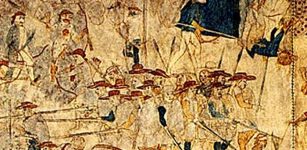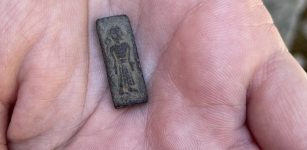Pharaoh Merneptah – His Giant Sarcophagus And Unique Victory Stele
A. Sutherland - AncientPages.com - Pharaoh Merneptah was Ramesses II’s 13th son. He succeeded his father when he was in his early sixties and reigned for ten years between 1213 B.C – 1203 B.C.
Greatly overshadowed by his dominant and long-lived father, Merneptah never had a chance to become a famous pharaoh, and he was almost unknown for most of his life. Yet, many Egyptologists believe that Merenptah was probably the real power behind the throne in the last decade of Ramesses II's life.
Merneptah makes an offering to Ptah on a column. Image credit: Chipdawes - Public Domain
In modern times, Pharaoh Merneptah has become famous for his extraordinary giant sarcophagus and unique Victory Stele, which offers the oldest evidence for Israel's existence in Canaan. However, some scholars disagree and say they have found even older evidence containing hieroglyphics that mention Israel.
Information about his military campaigns is documented on three great ancient inscriptions, including 80 lines on a wall in the Temple of Amun at Karnak, a large stele with 35 readable lines from Athribis in the Delta, and the great Victory Stele from his ruined mortuary temple at Thebes, with 28 lines.
Pharaoh Merneptah’s Victory Stele And Its Connection To Ancient Israel
Found in 1896, the Victory Stele became of great interest to Biblical scholars. Written in hieroglyphs, the text on the stele reads: "Canaan is plundered with every evil way. Ashkelon is conquered and brought away captive, Gezer seized, Yanoam made nonexistent; Israel is wasted, bare of seed."
Merneptah Stele known as the Israel stela (JE 31408) from the Egyptian Museum in Cairo. Credit: Webscribe - CC BY-SA 3.0
The ancient Egyptian inscription dates to about 1205 B.C. and recounts the military conquests of the pharaoh Merneptah. The Hebrews had conquered the land of Canaan around 1400 B.C.
Israel must have been of great importance to Pharaoh Merneptah because he wanted to memorize his victory. The discovery of the Stele of Pharaoh Merneptah led many scholars to believe this was the earliest mention of Israel.
However, Egyptologists and Biblical scholars Manfred Görg, Peter van der Veen and Christoffer Theis suggest that there may be an even earlier reference to Israel in the Egyptian record. Görg found a broken statue pedestal in the Egyptian Museum of Berlin containing hieroglyphic name-rings.
A study of the ancient Egyptian artifact revealed that one of the name rings should be read as “Israel.” Not all Biblical scholars agree with this interpretation, but if Görg is correct, the Egyptian statue in the Museum of Berlin is the oldest discovered reference to Israel. The inscription examined by Görg is dated around 1400 B.C.E.—about 200 years earlier than the Merneptah Stele.
Pharoah Merneptah’s Huge Sarcophagus - The Largest Ever Discovered In Egypt
Pharaoh Merneptah may not have been a famous ruler. Still, he certainly did receive an extraordinary burial box decorated with illustrations from Egyptian books of the afterlife that describe the sun god’s journey into the realm of the dead.
The lid of the second sarcophagus bearing an image of Merneptah. This would have been completely enclosed by the outer sarcophagus box and lid. Credit: Hajor - source
Some years ago, archaeologists discovered the largest ancient Egyptian sarcophagus in a tomb in the Valley of the Kings. It belonged to Pharaoh Merneptah.
He was buried in four nested stone sarcophagi! According to researchers and conservators at the Royal Ontario Museum in Toronto, Pharaoh Merneptah’s mummy was placed within a series of four nested sarcophagi, the outermost of which measures 13 feet long, 7 feet wide, and more than 8 feet tall.
Project director Edwin Brock, a research associate at the Royal Ontario Museum in Toronto, explained that the sarcophagi box was so large that workers could not get it through the door. Ultimately, they had to destroy the chamber's door jams and build new ones.
Imaginary portrait of Merenptah in a nineteenth-century engraving. Image credit: Burger, Ludwig -CC BY-SA 2.5
Evidence of this can be seen on the holes in the entrance shaft to the tomb that indicating a pulley system of sorts, with ropes and wooden beams workers must have used to bring the sarcophagi in.
According to Biblical Archaeology Review, “when Brock examined the tomb remains in the 1980s, fragments of the two outer sarcophagi were simply piled up in a side chamber. The two granite boxes had been smashed to pieces in antiquity following a tomb robbery more than 3,000 years ago. At that time, Merneptah’s mummy was reburied, and the second inner sarcophagus was reused by a later ruler. The third sarcophagus was topped with an oval cartouche-shaped lid depicting Merneptah. Only a third of the outermost sarcophagus remains (in fragments), but its lid is intact.”
Why was Pharaoh Merneptah, who was not a famous ruler, put to rest in such a large sarcophagus? This is a question no one has yet been able to answer. For some reason, Pharaoh Merneptah’s burial boxes were far more elaborate than his father’s and grandfather’s.
Scientists suggest it’s possible that Merneptah needed a box with large surfaces to depict the extensive ritual illustrations and magical spells that are repeated numerous times across the four sarcophagi.
Updated on January 7, 2024
Written by – A. Sutherland AncientPages.com Staff Writer
Copyright © AncientPages.com All rights reserved. This material may not be published, broadcast, rewritten or redistributed in whole or part without the express written permission of AncientPages.com
Expand for referencesManassa, Colleen. In The Great Karnak Inscription of Merneptah: Grand Strategy in the 13th Century BC, V-Vi.
Biblical Archaeology Review 39:3, May/June 2013 - Strata: Pharaoh Merneptah’s Massive Burial Box
More From Ancient Pages
-
 Mysterious Ancient Shapeshifters Who Guided Humans And The Battle Of The Gods Described In Sacred Texts And Myths
Featured Stories | Oct 27, 2021
Mysterious Ancient Shapeshifters Who Guided Humans And The Battle Of The Gods Described In Sacred Texts And Myths
Featured Stories | Oct 27, 2021 -
 Australia’s First Marine Aboriginal Archaeological Site Questioned
Archaeology | Jun 22, 2022
Australia’s First Marine Aboriginal Archaeological Site Questioned
Archaeology | Jun 22, 2022 -
 On This Day In History: Spanish Villasur Expedition Wiped Out By Pawnee And Otoe Warriors – On August 14, 1720
News | Aug 14, 2016
On This Day In History: Spanish Villasur Expedition Wiped Out By Pawnee And Otoe Warriors – On August 14, 1720
News | Aug 14, 2016 -
 First Crusade Was Launched In 1095
Ancient History Facts | Jun 19, 2018
First Crusade Was Launched In 1095
Ancient History Facts | Jun 19, 2018 -
 Why Winter Solstice Matters Around The World
Archaeoastronomy | Dec 20, 2022
Why Winter Solstice Matters Around The World
Archaeoastronomy | Dec 20, 2022 -
 Okanagan Indians’ Myth Of A Lost Island Paradise Inhabited By White Giants – Are Their Descendants Living In British Columbia?
Featured Stories | Dec 29, 2020
Okanagan Indians’ Myth Of A Lost Island Paradise Inhabited By White Giants – Are Their Descendants Living In British Columbia?
Featured Stories | Dec 29, 2020 -
 Boreas – Mighty North Wind God In Greek Mythology
Featured Stories | Mar 26, 2023
Boreas – Mighty North Wind God In Greek Mythology
Featured Stories | Mar 26, 2023 -
 Curse Of The Scottish Fyvie Castle That Survived Generations
Featured Stories | May 5, 2020
Curse Of The Scottish Fyvie Castle That Survived Generations
Featured Stories | May 5, 2020 -
 Rare And Tiny Ancient Stamps Found In Falster May Show The Way To An Unknown King’s Home
Archaeology | Jul 26, 2023
Rare And Tiny Ancient Stamps Found In Falster May Show The Way To An Unknown King’s Home
Archaeology | Jul 26, 2023 -
 Crimean Atlantis: Remarkable Ancient Underwater City Of Akra
Featured Stories | Mar 6, 2017
Crimean Atlantis: Remarkable Ancient Underwater City Of Akra
Featured Stories | Mar 6, 2017 -
 Mystery Of The ‘Mummified Mermaid’ In Japan Solved!
News | Feb 19, 2023
Mystery Of The ‘Mummified Mermaid’ In Japan Solved!
News | Feb 19, 2023 -
 Silent Witnesses: Further Dark Secrets Of Batavia Shipwreck – Uncovered
Archaeology | May 11, 2023
Silent Witnesses: Further Dark Secrets Of Batavia Shipwreck – Uncovered
Archaeology | May 11, 2023 -
 Temple Of Lord Vishnu Dated To Hindu Shahi Dynasty Unearthed In Pakistan
Archaeology | Nov 22, 2020
Temple Of Lord Vishnu Dated To Hindu Shahi Dynasty Unearthed In Pakistan
Archaeology | Nov 22, 2020 -
 Top 10 Archaeological Discoveries 2023
Archaeology | Dec 27, 2023
Top 10 Archaeological Discoveries 2023
Archaeology | Dec 27, 2023 -
 Spectacular 2,500 Years Old Shwedagon Pagoda In Myanmar – World’s Oldest Pagoda
Featured Stories | Oct 18, 2018
Spectacular 2,500 Years Old Shwedagon Pagoda In Myanmar – World’s Oldest Pagoda
Featured Stories | Oct 18, 2018 -
 Mystery Of The Yaghan People: The First True Discoverers Of America?
Civilizations | Sep 19, 2016
Mystery Of The Yaghan People: The First True Discoverers Of America?
Civilizations | Sep 19, 2016 -
 Winged Sun Disk: One Of The Oldest And Most Important Solar And Religious Symbols
Ancient Symbols | Mar 15, 2019
Winged Sun Disk: One Of The Oldest And Most Important Solar And Religious Symbols
Ancient Symbols | Mar 15, 2019 -
 Chonchon ‘Tue Tue’ Bird With Human Head Brought Bad Omens To Places It Haunted In Beliefs Of Mapuche Indians
Myths & Legends | Mar 12, 2024
Chonchon ‘Tue Tue’ Bird With Human Head Brought Bad Omens To Places It Haunted In Beliefs Of Mapuche Indians
Myths & Legends | Mar 12, 2024 -
 Controversial Prehistoric Bronze Gears Of Peru
Artifacts | Aug 15, 2015
Controversial Prehistoric Bronze Gears Of Peru
Artifacts | Aug 15, 2015 -
 Mysterious Skull Cult At Göbekli Tepe – Ancestor Worship Or Trophies Of Dead Enemies?
Archaeology | Jul 25, 2017
Mysterious Skull Cult At Göbekli Tepe – Ancestor Worship Or Trophies Of Dead Enemies?
Archaeology | Jul 25, 2017




